Contents
- Traditional and Modern Eating Practices
- Vegetarianism and Dietary Restrictions Across Communities
- Meals of the Day
- How Spicy is the Food?
- Local Produce
- Pickles
- Baby Food and Tiffin Boxes
- Festival and Seasonal Delicacies
- Wedding Food
- Prasad and Bhandara
- Smoking, Drinking and Substance Use
- Local Culinary Traditions
- Vangyache Bharit
- Shev Bhaji
- Bibdi
- Shegaon Kachori
- Sheera
- Banana Roti/Bhakri
- Khandeshi Mutton Curry
- Ghotleli Bhaji
- Kaalya Masalyachi Curry with Patoday
- Dubuk Vadi
- Meva Sweets
- Khapra Warchi Puranpoli
- Takatla Palak or Patal Bhaji
- Khandeshi Bhakri
- Traveled Culinary Traditions
- Mandi
- Batti Varan
- Eating Out
- Dhananjay Sheth
- Lokpriya Restaurant
- Amrut Raswanti, Chalisgaon
- Self Help Groups
JALGAON
Food
Last updated on 22 July 2025. Help us improve the information on this page by clicking on suggest edits or writing to us.
Jalgaon’s food culture is dominated by Khandeshi cuisine, which is popular for its charred, earthy flavours and large amounts of spice. Vangyacha (brinjal) Bharit is always the star of the show in Jalgaon. Additionally, the staple khandeshi thali has a vegetable, bhakri, rice and some kadhi/buttermilk and thecha (a chilli preparation) that adds some extra spice.
Traditional and Modern Eating Practices
Presently, owing to improved economic conditions, the diet has undergone a significant change. Traditionally, the main diet in Jalgaon consisted primarily of bhakri and bhaji. Sorghum was the primary pulse in the diet of the rural population, but now other pulses such as tur dal, udi dal, mugachi dal, and gram dal have been incorporated into their meals.
The major staple grains now consumed include jowar, bajra, gehu (wheat), and tandul (rice). In the past, households preferred sourcing their milk from local gaushalas or dairy farms due to their belief that it was fresher and of better quality. However, this has changed to some extent. Many people now accept packaged milk for its convenience, though some still adhere to traditional practices. The increased accessibility of milk has led to a rise in the production of milk-based items such as lassi.
Vegetarianism and Dietary Restrictions Across Communities
In the district, most people consume vegetarian food on most days, though they occasionally eat non-vegetarian food as well. However, among Muslims, indigenous communities, and the Tadvi community, non-vegetarian food is consumed more frequently.
Meals of the Day
![Jalgaon Banana Chips[1]](/media/culture/images/maharashtra/jalgaon/food/jalgaon-banana-chips1-ec8282c6.png)
In the rural areas of Jalgaon district, households typically have two meals a day. Lunch is usually served during the late morning hours, while dinner is around the early to mid-evening hours. This timing aligns with their lifestyle, allowing them to fuel up early in the day and wind down earlier in the evening.
In contrast, urban households generally have three meals. Breakfast is eaten early in the morning, lunch is served during the late morning to early afternoon hours (sometimes as late as mid-afternoon), and dinner often occurs during the mid to late evening hours. This schedule may be influenced by factors such as work hours, commuting time, and social activities that extend later into the day.
Rassa Poha and moong sprouts are among the most common breakfast dishes across the district. Lunch and dinner typically include Varan Bhatti, Bharit Puri, and Bhaji. Sweets are often served when guests visit. Notably, between lunch and dinner, people usually take a small break for tea or coffee, accompanied by snacks known locally as namkeen. One popular snack item in the district is banana chips, made from locally grown bananas. Other snack options include Vada Pav, Moong Bhajji, and Shev.
How Spicy is the Food?
In Jalgaon district, the food is generally spicy. While Gujjars (people originally from Gujarat), Brahmins, and other communities use chilli in smaller amounts, farmers and labourers often consume chilli paste known as thecha and spicy dry chutney. Overall, most of the food in the district is characterised by its heat and spiciness.
Local Produce
The district is well-known for its sugarcane farming, which is turned into tasty sugarcane juice, often mixed with lemon and chaat masala. This refreshing drink can be found along the highway and near major mandirs and cultural sites, making it a favourite among locals and visitors.
Besides sugarcane, the district grows a variety of crops. Some important ones include cotton, sorghum, dal, wheat, rice, and bananas. The southern part of the district, including Bhadgaon, Chalisgaon, Jamner, and Erandol talukas, is famous for its citrus fruits like lemons, oranges, guavas, and sapota (chikku).
Talukas such as Parola, Erandol, and Jamner are especially known for producing bananas, soybeans, cotton, wheat, maize, pulses, and groundnuts. One interesting thing about the fruit and vegetable markets in Jalgaon is that the produce is often quite large. This is due to the good climate and rich soil in the area, along with the use of hybrid seeds. Additionally, local specialities like banana chips have gained recognition and received a Geographical Indication (GI) tag. This tag highlights their unique quality and importance to the region.
Pickles
Kairi (raw mango) pickles in Jalgaon district are quite famous along with sweet and sour mango pickles, lemon pickles, carrot pickles, etc. Apart from pickles, chutney is also an important part of the daily diet. Particularly, Nisty Chutney which is made by combining oil, dry red chillies, garlic cloves, small pieces of tamarind, little jaggery, coriander, salt and water, is eaten often.
![Nisty Chutney[2]](/media/culture/images/maharashtra/jalgaon/food/nisty-chutney2-81928c98.jpg)
![Lemon Pickle[3]](/media/culture/images/maharashtra/jalgaon/food/lemon-pickle3-9553c85a.jpg)
![Carrot Pickle[4]](/media/culture/images/maharashtra/jalgaon/food/carrot-pickle4-e35b1118.png)
Baby Food and Tiffin Boxes
The first foods for babies vary across different communities. For the Hindu community, babies are often introduced to rice or wheat kheer, mashed fruits like bananas, and vegetable purees such as sweet potato. The Muslim community commonly starts with rice kheer and mashed or pureed dates. Buddhist families introduce their babies to rice kheer and mung bean soup, while the Sikh community prefers dalia (broken wheat), kheer and moong dal soup. Christian families often feed their babies rice kheer, mashed potatoes, and soft vegetables. Jain families typically offer fruit purees like banana or apple, and sabudana (tapioca) kheer. Across all these communities, rice-based kheer and mashed fruits are common and favoured first foods for babies, reflecting a shared emphasis on gentle and nutritious weaning foods.
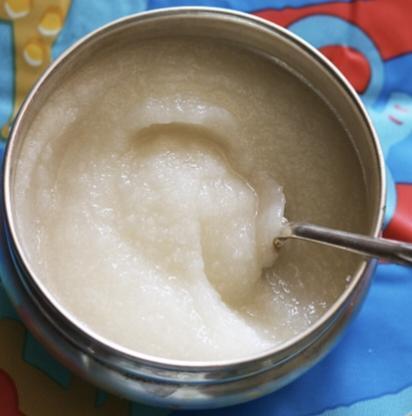
When it comes to the food taken by children in their tiffin, the options mostly include simple and nutritious food items like roti with bhaji, rice with dal, Khichadi, Pohe, Upma, Parathas, fruits or homemade snacks like Chivda, Ladu, Shev, Murmure or Thalipeeth, etc.
Festival and Seasonal Delicacies
Puran Poli, a sweet dish popular across Maharashtra, is primarily consumed during festivals like Sankranti in January. This dessert is often served with hot ghee and milk. On Diwali, sweets such as Ladoo and Karanji, along with snacks like Chivda, are prepared and shared with relatives. Other winter delicacies include Revdi and Rajgira, which are similar to Chikki and made from sesame seeds and jaggery. The seasonal fruits available in the district include bananas, mangoes, watermelons, grapes, jamun, litchis, pomegranates, papayas, oranges, guavas, and sugarcane, each available at different times of the year.
Wedding Food
Weddings in rural areas often focus on traditional dishes. Common foods include Varan-Batti, vegetable curry, roti/chapatti, sweet Boondi, papad, and loncha. These dishes connect guests to their culture and use local ingredients. In contrast, urban weddings offer a mix of different cuisines. Menus often include Maharashtrian dishes, popular Chinese foods, and a combination of North and South Indian specialities. Many urban weddings also feature fusion cuisine, mixing traditional Indian dishes with international flavours, such as butter chicken pizza and tandoori tacos.

Prasad and Bhandara
In most mandirs across the district, Sabudana Khichdi is offered as prasad on Kartiki Ashadhi Ekadashi, while a mixture of coriander powder, ginger powder, and sugar is given on Ram Navami. During Navratri, it is customary to offer Sheera as prasad, while Murmure or Sheera is provided during the Ganapati festival. Pedha is also a very common prasad item. These are sold outside every Mandir. Pedha varieties such as Doodh Pedha, Mawa Pedha, Gur Pedha, Til Pedha and Nandan Pedha are commonly found. Kalakand is another option and is made of milk and sugar.
![Amsul Kadi[5]](/media/culture/images/maharashtra/jalgaon/food/amsul-kadi5-d02f05be.jpg)
At the Saibaba Mandir in the district, a Bhandara is held during Navratri, where dishes such as Varan Batti, Khichdi, Amsul Chi Kadi, buttermilk Kadi, and Sheera are served.
Smoking, Drinking and Substance Use
Alcohol consumption in the district is very low among both men and women. According to the NFHS-5 data, 0.5% of women aged 15 years and above consume alcohol, and the number for men is 12.3%. Tobacco consumption, on the other hand, is higher. According to the NFHS-5 data, 12.6% of Women and 37.7% of men aged 15 years and above use any kind of tobacco.
Local Culinary Traditions
Vangyache Bharit
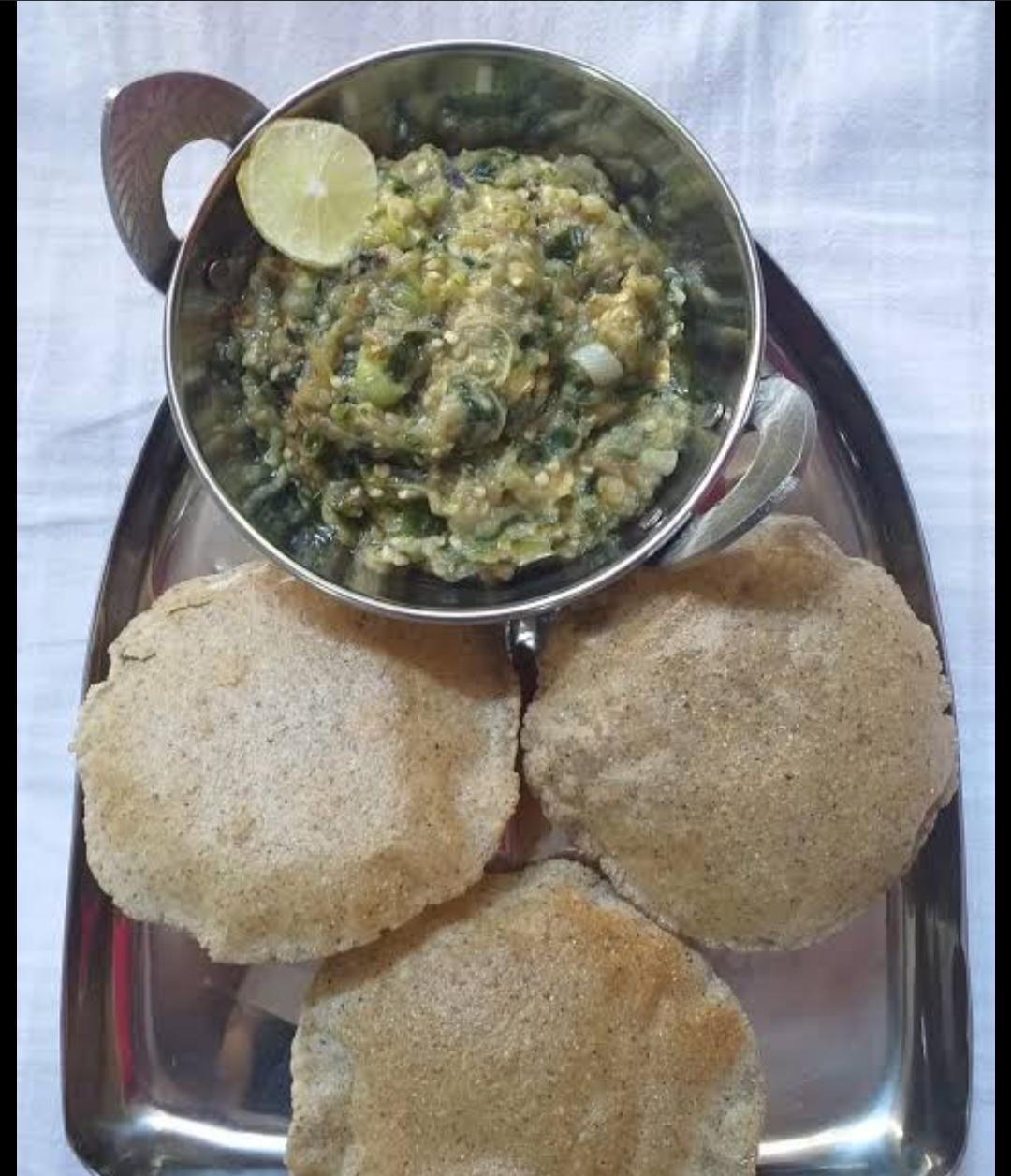
Bharit, commonly known as Bharta in other parts of India, is quite popular in the district. It is made using a special type of white brinjal that is cultivated across the district. The brinjal is kept on a fire for some time till it gets smoked from the inside and can be easily peeled. Then, peanuts, onions and chillies are sautéed and added to the preparation. The dish is then garnished with coriander. Bharit is eaten with jowar/ bajra bhakris or chapatis.
Shev Bhaji
![Shev Bhaji[6]](/media/culture/images/maharashtra/jalgaon/food/shev-bhaji6-8b3cac53.png)
Shev Bhaji is another popular preparation of Khandeshi cuisine. It is made in a rich and spicy red gravy (made of garlic, chilli powder, oil, ginger and many other spices), and shev (usually made of besan (gram flour)). Interestingly, Shev Bhaji is a common preparation in the district. The dish is also popular in parts of India like Gujarat and Rajasthan, where vegetables were historically difficult to cultivate.
Bibdi
Mostly served as papad, Bibdi is made of jeera, garlic, chillies and salt. It is made of rice flour and can be consumed fried or eaten steamed. Sometimes, it is also sold after drying.
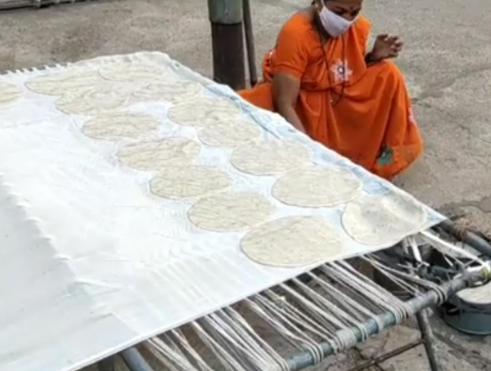
Shegaon Kachori
Shegaon Kachori is made from maida, moong dal, and chana dal (besan/ gram flour) and is commonly eaten as a snack, either in the mornings or evenings.
Sheera
Different varieties of Sheera are popularly consumed in the district. Sheera is a type of halwa made of rawa (semolina). In Jalgaon, a namkeen (salty) sheera is made of wheat and a sweeter version of semolina.
Banana Roti/Bhakri
Due to the extensive supply of bananas in the district, banana flour is used in some preparations. A common dish made of banana flour is banana roti. It is made like a usual chapati, replacing the wheat with banana flour. Banana flour is made by making a powder after drying bananas.
Khandeshi Mutton Curry
Khandeshi Mutton Curry is a speciality of Jalgaon. It is prepared by marinating mutton, then cooking it and adding diced onions, garlic, ginger and coconut flakes into the mixture. Red chilli powder, turmeric and black pepper are also added to the mix. The dish is quite spicy and is best eaten with jowar bhakris or chapati.
Ghotleli Bhaji
Dishes prepared with brinjal seem to be a favourite amongst locals of Jalgaon. Ghotleli bhaji is a type of mashed brinjal dish in which brinjals are first stir-fried, mashed and then cooked. Ginger, garlic, green chillies, curry leaves, turmeric, salt, cumin seeds and mustard are added to the mashed brinjals. The dish is seasoned with coriander leaves and has a spicy taste. It is eaten with chapati/ bhakri.
Kaalya Masalyachi Curry with Patoday
This dish is prepared with besan (gram flour), poppy seeds, black curry masala and roasted coconut pieces. Poppy seeds and roasted coconut pieces are filled inside besan rolls (patoday). These besan rolls are cooked in a kala masala curry.

Dubuk Vadi
Dubuk Vadi is a Khandeshi delicacy made with black masala curry, roasted onions, garlic and coconut flakes. In this curry, fried besan pakoras full of cumin seeds and turmeric are dipped. Red chilli powder, salt, garam masala and coriander powder are also added to give it a tangy taste. The dish is called Dubuk (drowned) vadi to represent the black masala curry-soaked vadis.
Meva Sweets
Many people from the Dhangar community in the district engage in livestock rearing and the dairy business. They make sweets from the Meva that is obtained through boiling and sweetening the milk.
Khapra Warchi Puranpoli
Puran Poli is common in other regions as well, but in Jalgaon district, the use of a Puran Yantra and a khapar (earthen pot) makes it truly special. Here, the Puran Poli is prepared by stuffing whole wheat flour dough with chana dal and jaggery. Using the Puran Yantra, small balls of dough are rolled into thin, even rotis. This tool ensures that the rotis are uniformly thin, resulting in a delicate and consistent final product. The stuffed roti is then placed on an inverted khapar, which is heated over a medium flame. The khapar imparts a unique earthy and smoky flavour to the Puran Poli, distinguishing it from those made on regular pans.
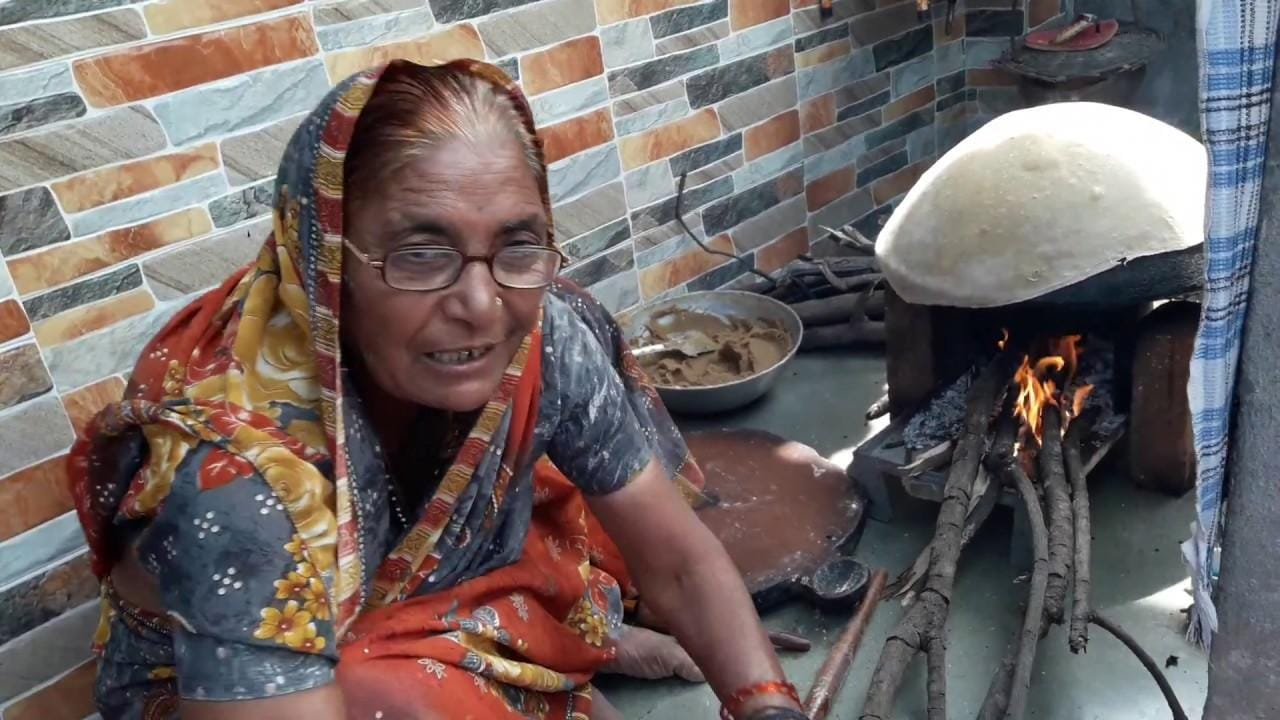
Takatla Palak or Patal Bhaji
![Takatla Palak or Patal Bhaji[7]](/media/culture/images/maharashtra/jalgaon/food/takatla-palak-or-patal-bhaji7-9cc84a86.jpg)
This is a delicious Maharashtrian recipe where spinach (palak) is cooked in a buttermilk gravy along with peanuts and chana dal, lending a delicious taste. This simple, slightly tangy curry served with rice is comforting not only in the hot summer months but all year round. If it is served with rice, the curry usually has a thin soup-like consistency or can be made thicker when it is to be served with chapati.
Khandeshi Bhakri
Khandeshi Bhakri is a traditional dish popular in the district. It is closely associated with the Khandeshi farmers' community, which has a significant presence in the district. Historically, farmers and labourers needed a filling and nutritious meal to sustain them through long hours of work in the fields. Bhakri, made from locally available grains like jowar or bajra, emerged as the ideal choice due to its simplicity in taste, ease of cooking, and ability to provide energy. Over time, the dish has become a staple.

Traveled Culinary Traditions
Mandi
Originating from Yemen, Mandi consists mainly of rice, meat (such as lamb or chicken), and a blend of spices, often cooked in a unique method that enhances its flavours. The dish is typically prepared in a pit or a tandoor, allowing the meat to cook slowly while infusing the rice with rich flavours from the spices and juices of the meat. With urbanisation, this dish has gained significant popularity and has become an integral part of the local food culture.
Batti Varan
This dish originated in Rajasthan and is similar to Dal Baati, a popular dish in the state. Due to migration, Batti Varan has become popular in the Khandesh and Marathwada regions. In Rajasthan, Dal Baati is circular in shape, but in Jalgaon, it is toast-like and rectangular. Additionally, the dal in Jalgaon is spicier than in Rajasthan. First, they mix soybean and wheat flour to make the batti, then they boil it. When serving, they deep fry it in oil, resulting in a dish that is crunchier on the outside and softer on the inside.
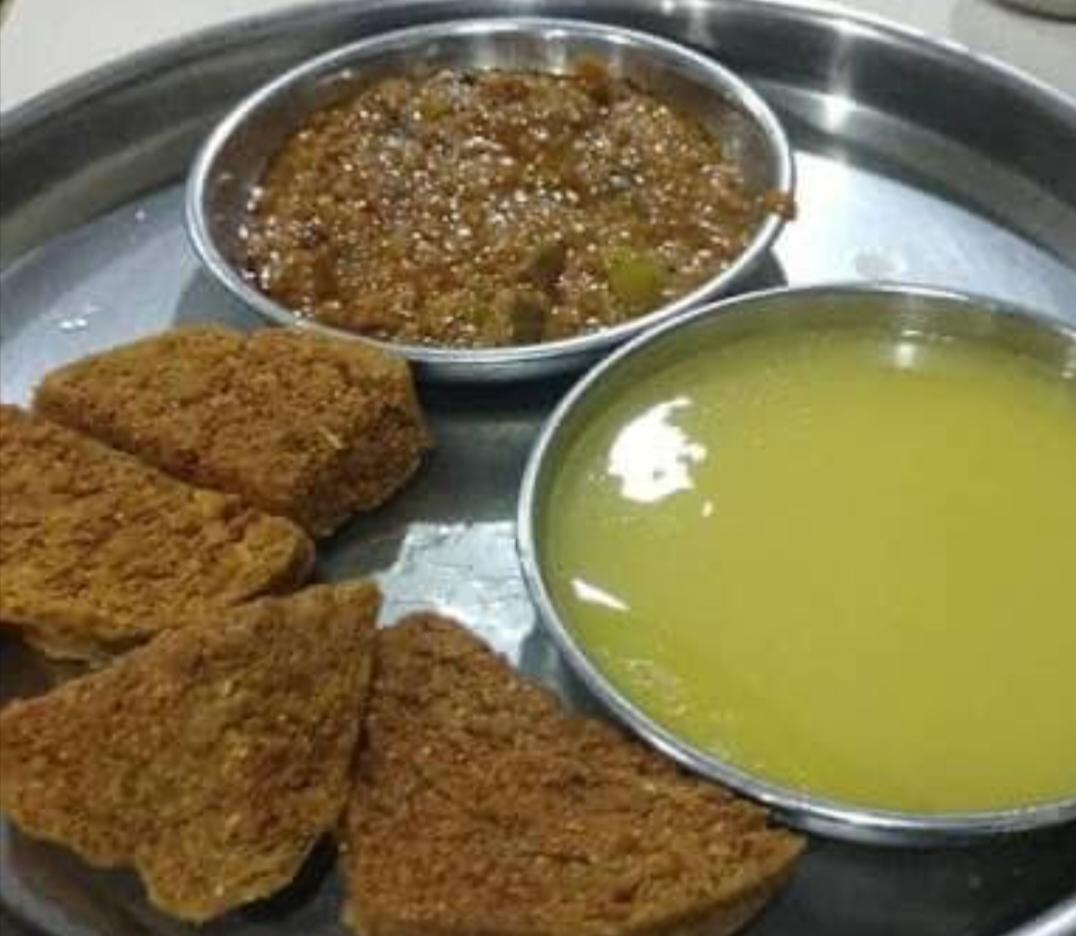
Eating Out
The eating-out culture has gained prominence among the younger generation in the district, while elderly people prefer to go out occasionally. Some hotels famous for vegetarian food include Hotel Step Inn, Hotel Gaurav, and Jalsa Hotel. Similarly, for non-vegetarian food, Jalpuri Hotel, Gulshan East, and Bole Mutton Hotel are well-known. It appears that street food culture is more prominent in the district than that of fancy eateries. Mahaveer Best Pav Bhaji, Sri Siddhivinayak Pav Bhaji, and Super Dabeli and Pani Puri Centre are some of the popular street food options in Jalgaon city. Hotel Dhanji Sheth in Faizpur village of Yawal taluka is also a renowned establishment.
Dhananjay Sheth
Dhananjay Sheth Hotel gets visitors from distant villages. This hotel is the only manufacturer of Daraba (made from pure ghee, rava (semolina), maida (flour), and sugar) in Jalgaon district to date. Breakfast items like Misal, Vada, and Kachori are booked and sold until 10:00 am.
Lokpriya Restaurant
Lokpriya Restaurant was established in 1960 by Kashinath Tukaram Khadke. It has earned a good reputation in the city and has become a landmark place to eat. Their special dishes include Misal, Fafda, Jalebi, and Bhaje.
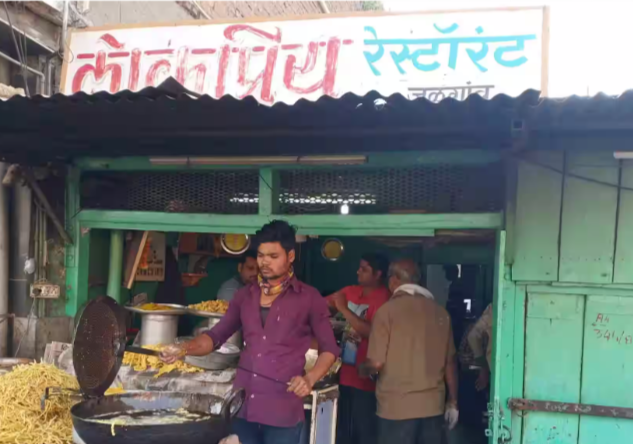
Amrut Raswanti, Chalisgaon
Specialising in freshly squeezed sugarcane juice, yoghurt-based lassi, and other refreshing beverages and ice cream, Amrut Raswanti is situated in the centre of Chalisgaon city and is one of the favourite hangout spots for the locals.
Self Help Groups
In Jalgaon, Lilam Gruh Udyog is a well-known self-help group that has flourished since its inception in a home kitchen. This popular business has rapidly expanded its offerings to include a variety of delicious snacks, such as Khakhra in multiple flavours, Chivda made from flattened rice, wafer laddoo, chikki, and other tasty treats. With its commitment to quality and innovation, Lilam Gruh Udyog has become a beloved name in the local snack industry.
Last updated on 22 July 2025. Help us improve the information on this page by clicking on suggest edits or writing to us.